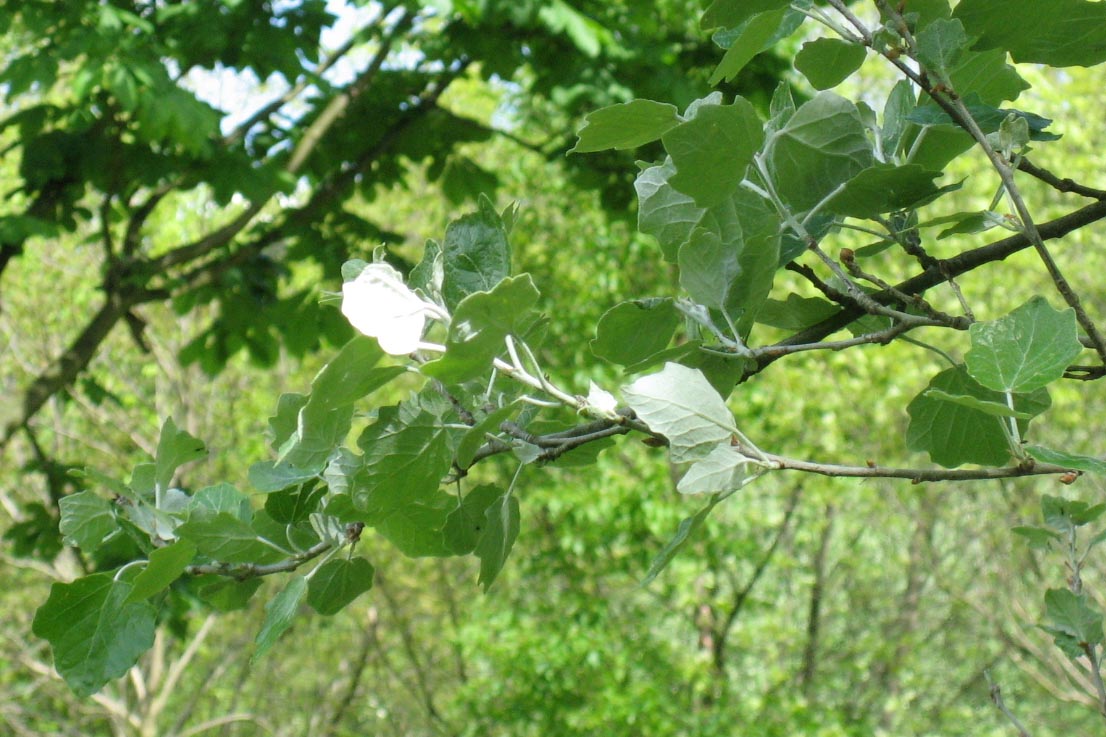- Populus alba
image_width = 240px
image_caption = White Poplar foliage
regnum =Plant ae
divisio = Magnoliophyta
classis = Magnoliopsida
ordo =Malpighiales
familia =Salicaceae
genus = "Populus"
sectio = "Populus"
species = "P. alba"
binomial = "Populus alba"
binomial_authority = L."Populus alba" (White Poplar) is a species of
poplar , most closely related to theaspen s ("Populus" sect. "Populus"). It is native fromSpain andMorocco through centralEurope (north toGermany andPoland ) to centralAsia . It grows in moist sites, often by watersides, in regions with hot summers and cold to mild winters.Flora Europaea: [http://rbg-web2.rbge.org.uk/cgi-bin/nph-readbtree.pl/feout?FAMILY_XREF=&GENUS_XREF=Populus&SPECIES_XREF=alba&TAXON_NAME_XREF=&RANK= "Populus alba"] ] Rushforth, K. (1999). "Trees of Britain and Europe". Collins ISBN 0-00-220013-9.]It is a medium-sized
deciduous tree , growing to heights of up to 16-27 m (rarely more), with a trunk up to 1 m diameter and a broad rounded crown. Thebark is smooth and greenish-white to greyish-white with characteristic diamond-shaped dark marks on young trees, becoming blackish and fissured at the base of old trees. The young shoots are covered with whitish-grey down, including the small buds. The leaves are 4-15 cm long, five-lobed, with a thick covering of white scurfy down on both sides but thicker underneath; this layer wears off the upper side but not the lower, which stays white until autumn leaf fall. Larger, deeply lobed leaves are produced on fast-growing young trees, and smaller, less deeply lobed leaves on older, slow-growing trees. Theflower s arecatkin s up to 8 cm long, produced in early spring; they are dioecious, with male and female catkins on separate trees; the male catkins are grey with conspicuous dark red stamens, the female catkins are greyish-green. The female catkins lengthen to 8–10 cm after pollination, with several green seed capsules, maturing in late spring to early summer. It also propagates by means of root suckers growing from the lateral roots, often as far as 20-30 m from the trunk, to form extensive clonal colonies.Flora of NW Europe: [http://ip30.eti.uva.nl/BIS/flora.php?selected=beschrijving&menuentry=soorten&id=2198 "Populus alba"] ]White Poplar hybridises with the closely related Common Aspen "
Populus tremula "; the resulting hybrid, known as Grey Poplar ("Populus × canescens"), is intermediate between its parents, with a thin grey downy coating on the leaves, which are also much less deeply lobed than White Poplar leaves. It is a very vigorous tree with marked hybrid vigour, reaching 40 m tall and over 1.5 m trunk diameter (much larger than either of its parents). Most Grey Poplars in cultivation are male, but female clones are occasionally found.Cultivation and uses
It requires abundant light and ample moisture, and stands up well to flood water and slightly acidic soils. Its green-and-white leaves makes it an effective
ornamental tree but the root suckers may cause problems in some situations. It is very attractive as an open-grown tree in water meadows, and, because of its extensive root system and tolerance of salt, is also planted to strengthen coastalsand dune s.Vedel, H., & Lange, J. (1960). "Trees and Bushes in Wood and Hedgerow". Metheun & Co. Ltd., London.]The majority of White Poplars in cultivation in northern Europe are female trees.
White poplar was first introduced to North America in 1748 and has a long history in cultivation. [http://www.nps.gov/plants/alien/fact/poal1.htm] It is now found in forty-three states throughout the contiguous U.S. [http://www.nps.gov/plants/alien/fact/poal1.htm] It has come to be considered weedy or invasive, and has been banned in Connecticut. [http://plants.usda.gov/java/profile?symbol=POAL7] [http://www.invasive.org/browse/subject.cfm?sub=3066] [http://www.nps.gov/plants/ALIEN/map/poal1.htm US invasive state location map]
It has been introduced into North America, especially along the east coast. It is a highly competitive tree and was the most common introduced tree species on
Cape Breton Island .Keeler, H. L. (1900). "Our Native Trees and How to Identify Them" pp. 428-432. Charles Scriber's Sons, New York]In intensive forest management it is being replaced by various
cottonwood hybrids. The wood is soft, and used to make cellulose and for cheap boxes.A conical
cultivar fromTurkestan , "Populus alba" 'Pyramidalis' (Bolle's Poplar; syn. "Populus bolleana") is sometimes planted in parks.History
An old English name "Abele", now rarely used, is derived from the
Latin "albellus", white, by way ofOld French "aubel" andLow German name "abeel".According to ancient mythology the White Poplar was consecrated to
Hercules because he destroyedCacus in a cavern adjoining theAventine Hill , which was covered with these trees; and in the moment of his triumph he bound his brows with a branch of White Poplar as a token of his victory. Persons offering sacrifices to Hercules were always crowned with branches of this tree; and all who had gloriously conquered their enemies in battle wore garlands of it, in imitation of Hercules.Homer in the "Iliad" compares the fall ofSimoisius when killed by Ajax to that of a poplar. quote|So falls a poplar that on watery ground
Raised high its head with stately branches crowned.Ovid mentions that Paris had carved the name of Ænone on a poplar, as Shakespeare has Orlando carve the name of Rosalind upon the trees of the forest of Arden.Virgil gives directions for the culture of this tree andHorace speaks of the White Poplar as delighting to grow on the banks of rivers.References
External links
* [http://www.duke.edu/~cwcook/trees/poal.html leaf photos]
* [http://www.hainaultforest.co.uk/5Grey%20poplar.htm Tree identification]
Wikimedia Foundation. 2010.

